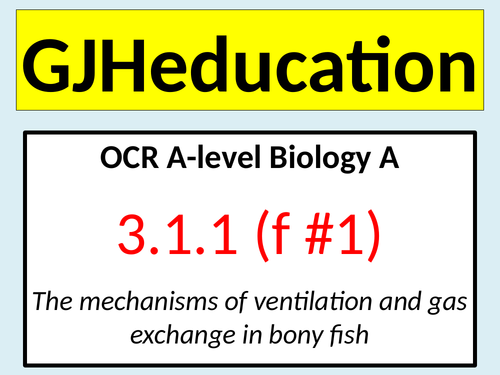



This lesson describes the roles of the buccal cavity, operculum, gill lamellae and countercurrent flow in ventilation and gas exchange in bony fish. The detailed PowerPoint and accompanying resources are part of the first lesson in a series of 2 that have been designed to cover the details of point 3.1.1 (f) of the OCR A-level Biology A specification. The second lesson in this series covers the mechanisms of ventilation and gas exchange in insects.
The lesson has been specifically planned to prepare students for the content of module 3.1.2 (Transport in animals) and therefore begins with an introduction and a brief description of the single circulatory system of a fish as this has an impact on the delivery of deoxygenated blood to the lamellae. A quick quiz competition is used to introduce the operculum and then the flow of blood along the gill arch and into the primary lamellae and then into the capillaries in the secondary lamellae is described. The next task challenges the students to use their knowledge of module 2 to come up with the letters that form the key term, countercurrent flow. This is a key element of the lesson and tends to be a feature that is poorly understood, so extra time is taken to explain the importance of this mechanism. Students are shown two diagrams, where one contains a countercurrent system and the other has the two fluids flowing in the same direction, and this is designed to support them in recognising that this type of system ensures that the concentration of oxygen is always higher in the oxygenated water than in the blood in the lamellae. The remainder of the lesson focuses on the coordinated movements of the buccal-opercular pump to ensure that the water continues to flow over the gills.
Current understanding and prior knowledge checks are included throughout the lesson and students can assess their progress against the mark schemes which are embedded into the PowerPoint
Get this resource as part of a bundle and save up to 33%
A bundle is a package of resources grouped together to teach a particular topic, or a series of lessons, in one place.
Module 3: Exchange and transport (OCR A-level Biology A)
This bundle contains 18 detailed and engaging lessons which cover the following specification points in module 3 (Exchange and transport) of the OCR A-level Biology A specification: 3.1.1: Exchange surfaces * The need for specialised exchange surfaces * The features of an efficient exchange surface * The structures and functions of the components of the mammalian gaseous exchange system * The mechanism of ventilation in mammals * The mechanisms of ventilation and gas exchange in bony fish and insects 3.1.2: Transport in animals * The double, closed circulatory system in mammals * The structure and functions of arteries, arterioles, capillaries, venules and veins * The formation of tissue fluid from plasma * The external and internal structure of the heart * The cardiac cycle * How heart action is initiated and coordinated * The use and interpretation of ECG traces * The role of haemoglobin in transporting oxygen and carbon dioxide * The oxygen dissociation curve for foetal and adult haemoglobin 3.1.3: Transport in plants * The structure and function of the vascular systems in the roots, stems and leaves * The transport of water into the plant, through the plant and to the air surrounding the leaves * The mechanism of translocation As well as the detailed A-level Biology content of the PowerPoint slides, the resources contain a wide range of tasks including guided discussion points, exam-style questions and quiz competitions which will engage and motivate the students
Module 3.1.1: Exchange surfaces (OCR A-level Biology A)
This lesson bundle contains 5 lesson PowerPoints and together with their accompanying worksheets, they will engage and motivate the students whilst covering the following specification points in module 3.1.1 (Exchange surfaces) of the OCR A-level Biology A specification: * The need for specialised exchange surfaces * The features of an efficient exchange surface * The structures and functions of the components of the mammalian gaseous exchange system * The mechanism of ventilation in mammals * The mechanisms of ventilation and gas exchange in bony fish and insects Found interspersed within the detailed A-level Biology content in the slides are current understanding and prior knowledge checks and these are followed by displayed mark schemes to allow students to assess their progress. There are also differentiated tasks, guided discussion periods and quiz competitions that introduce key values and terms in a fun and memorable way If you would like to see the quality of lessons included in this bundle, then download the mammalian gaseous exchange system and ventilation and gas exchange in insects lessons as these have been uploaded for free
Something went wrong, please try again later.
Clearly a lot of effort has gone into making the quiz interactive but this is not what I was expecting, not sure I would teach this without a single diagram in the PPT.
I love GJHeducation resources, and so do my students. They are well written, pitched brilliantly (and I love the ‘Star’ additions) and the links to previous and future units are great. The students love the quiz aspects. These have saved me so much time and perfectly suit my style of teaching - lots of opportunities for verbal assessment and feedback. Worth every penny.
Report this resourceto let us know if it violates our terms and conditions.
Our customer service team will review your report and will be in touch.